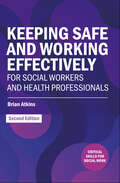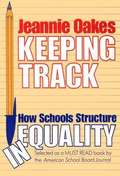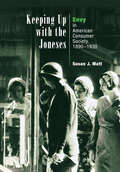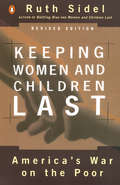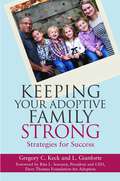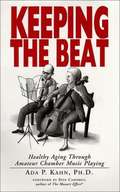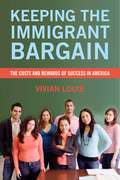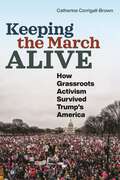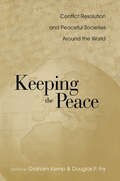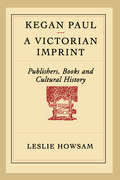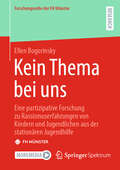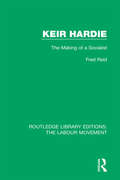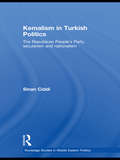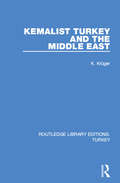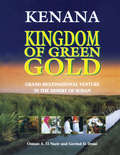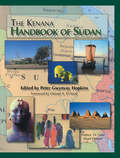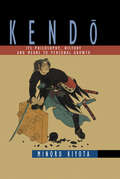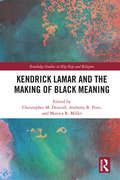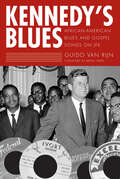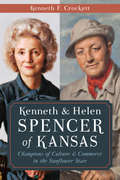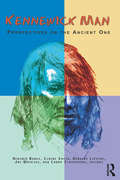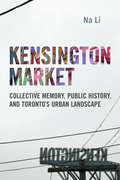- Table View
- List View
Keeping Promises: The Royal Proclamation of 1763, Aboriginal Rights, and Treaties in Canada (McGill-Queen's Indigenous and Northern Studies #78)
by Terry Fenge Jim AldridgeIn 1763 King George III of Great Britain, victorious in the Seven Years War with France, issued a proclamation to organize the governance of territory newly acquired by the Crown in North America and the Caribbean. The proclamation reserved land west of the Appalachian Mountains for Indians, and required the Crown to purchase Indian land through treaties, negotiated without coercion and in public, before issuing rights to newcomers to use and settle on the land. Marking its 250th anniversary Keeping Promises shows how central the application of the Proclamation is to the many treaties that followed it and the settlement and development of Canada. Promises have been made to Aboriginal peoples in historic treaties from the late eighteenth to the early twentieth centuries in Ontario, the Prairies, and the Mackenzie Valley, and in modern treaties from the 1970s onward, primarily in the North. In this collection, essays by historians, lawyers, treaty negotiators, and Aboriginal leaders explore how and how well these treaties are executed. Addresses by the governor general of Canada and the federal minister of Aboriginal Affairs and Northern Development are also included. In 2003 Aboriginal leaders formed the Land Claims Agreements Coalition to make sure that treaties – building blocks of Canada – are fully implemented. Unique in breadth and scope, Keeping Promises is a testament to the research, advocacy, solidarity, and accomplishments of this coalition and those holding the Crown to its commitments.
Keeping Safe and Working Effectively For Social Workers and Health Professionals (Critical Skills for Social Work)
by Brian AtkinsSocial workers and health professionals are often placed in situations where they are verbally or physically threatened by service users and others. This book helps them recognise potential risks in situations, when to avoid involvement, and how best to manage these risks, giving them the confidence to work effectively.Suitable for practitioners, students, leaders and supervisors, this book covers topics such as managing risks, improving safety awareness, teamwork and organisational support within the modern-day context. Specifically, this second edition includes: Interviews from current senior and first line managers in children’s and adult social care and health services, front line staff and more. A new chapter on managing online and digital issues including managing the transition of back to work after Covid-19. Greater emphasis on the responsibilities of employers and their duty of care to staff. Further elaboration on the impairment of decision-making under stress caused by imitation and threat. The use of new therapeutic approaches in reducing threat from service users and better responding to their needs. This book helps students to become aware of the factors which may affect judgement in child protection cases and assist in managing cases on placement. It helps professional practitioners in managing the anxieties associated with their current case load and provides strategies to manage these unfortunately common workplace experiences.
Keeping Track: How Schools Structure Inequality
by Jeannie OakesDiscussion of the system of "tracking", where student are grouped and taught according to their ability.
Keeping Up with the Joneses
by Susan J. MattA century ago many Americans condemned envy as a destructive emotion and a sin. Today few Americans expect criticism when they express envy, and some commentators maintain that the emotion drives the economy. This shift in attitude is Susan Matt's central concern. Keeping up with the Joneses: Envy in American Consumer Society, 1890-1930 examines a key transition in the meaning of envy for the American middle class. Although people certainly have experienced envy throughout history, the expansion of the consumer economy at the turn of the twentieth century dramatically reshaped the social role of the emotion. Matt looks at how different groups within the middle class--men in white-collar jobs, bourgeois women, farm families, and children--responded to the transformation in social and cultural life.Keeping Up with the Joneses traces how attitudes about envy changed as department stores, mail-order catalogs, magazines, movies, and advertising became more prevalent, and the mass production of imitation luxury goods offered middle- and working-class individuals the opportunity to emulate upper-class life. Between 1890 and 1910 moralists sought to tame envy and emulation in order to uphold a moral economy and preserve social order. They criticized the liberal-capitalist preoccupation with personal striving and advancement and praised the virtue of contentment. They admonished the bourgeoisie to be satisfied with their circumstances and cease yearning for their neighbors' possessions. After 1910 more secular commentators gained ground, repudiating the doctrine of contentment and rejecting the notion that there were divinely ordained limits on what each class should possess. They encouraged everyone to pursue the objects of desire. Envy was no longer a sin, but a valuable economic stimulant.The expansion of consumer economy fostered such institutions as department stores and advertising firms, but it also depended on a transformation in attitudes and emotional codes. Matt explores the ways gender, geography, and age shaped this transformation. Bridging the history of emotions and the history of consumerism, she uncovers the connection between changing social norms and the growth of the consumer economy.
Keeping Women and Children Last Revised
by Ruth SidelIn Keeping Women and Children Last, Ruth Sidel shows how America, in its search for a post-Cold War enemy, has turned inward to target single mothers on welfare, and how politicians have scapegoated and stigmatized female-headed families both as a method of social control and to divert attention from the severe problems that Americans face. She reveals the real victims of poverty--the millions of children who suffer from societal neglect, inferior education, inadequate health care, hunger, and homelessness. In this new edition, focusing on the passage of the Personal Responsibility and Work Opportunity Reconciliation Act of 1996, Sidel reevaluates our social policy, assessing the impact of the "end of welfare as we know it" on America's poor, especially its women and children.
Keeping Women in Their Digital Place: The Maintenance of Jewish Gender Norms Online
by Ruth TsuriaSince its inception, the internet has been theorized as a democratic force, a public sphere in which hierarchies are flattened. But the internet is not a neutral tool; it has the power to amplify and mirror certain opinions and, as a result, can concretize social norms. So what happens when matters of religious practice and gender identity collide in these—often unregulated—online spaces?In Keeping Women in Their Digital Place, Ruth Tsuria explores how Orthodox Jewish communities in the United States and Israel have used “digital enclaves”—online safe havens created specifically for their denominations—to renegotiate traditional values in the face of taboo discourse encountered online. Combining a personal narrative with years of qualitative analysis, Tsuria examines how discussions in blogs and forums and on social media navigate issues of modesty, dating, marriage, intimacy, motherhood, and feminism. Unpacking the complexity of religious uses of the internet, Tsuria shows how the participatory qualities of digital spaces have been used both to challenge accepted norms and—more pervasively—to reinforce traditional and even extreme attitudes toward gender and sexuality.Original and engaging, this book will appeal to media, feminist, and religious studies scholars and students, particularly those interested in religion in the digital age and Orthodox Jewish communities.
Keeping Your Adoptive Family Strong: Strategies for Success
by Rita L. Soronen Greg Keck L GianforteWelcoming a new child into the home through adoption is a life-altering experience-for the child, the parents, and everyone else in the family. Expectations and realities often differ dramatically, and adjusting to the change can be difficult and emotionally painful. Since the majority of children available for adoption today are in the system as the result of abuse and neglect, parents must acknowledge the fact they these young innocents will carry their trauma with them into their new homes. A willingness to address the not-so-easy, didn't-see-that-coming aspects of adoption is the first step toward building a strong family. A valuable resource for parents and professionals, this book provides useful strategies for facing the challenges posed by adopted children. The inclusion of real stories from real people adds heart and encouragement, offering hope for the future of the entire family.
Keeping the Beat: Healthy Aging Through Amateur Chamber Music Playing
by Ada P. KahnDust off your clarinet! You can express yourself and improve your health through music. Ada Kahn's Keeping the Beat encourages older amateur musicians who play violins, cellos, flutes, and recorders to make joyful sounds with others.
Keeping the Immigrant Bargain: The Costs and Rewards of Success in America
by Vivian LouieMost nineteenth and early-twentieth-century European immigrants arrived in the United States with barely more than the clothes on their backs. They performed menial jobs, spoke little English, and often faced a hostile reception. But two or more generations later, the overwhelming majority of their descendants had successfully integrated into American society. Today's immigrants face many of the same challenges, but some experts worry that their integration, especially among Latinos, will not be as successful as their European counterparts. Keeping the Immigrant Bargain examines the journey of Dominican and Colombian newcomers whose children have achieved academic success one generation after the arrival of their parents. Sociologist Vivian Louie provides a much-needed comparison of how both parents and children understand the immigrant journey toward education, mobility, and assimilation. Based on Louie's own survey and interview study, Keeping the Immigrant Bargain examines the lives of thirty-seven foreign-born Dominican and Colombian parents and their seventy-six young adult offspring—the majority of whom were enrolled in or had graduated from college. The book shows how they are adapting to American schools, jobs, neighborhoods, and culture. Louie discovers that before coming to the United States, some of these parents had already achieved higher levels of education than the average foreign-born Dominican or Colombian, and after arrival many owned their own homes. Significantly, most parents in each group expressed optimism about their potential to succeed in the United States, while also expressing pessimism about whether they would ever be accepted as Americans. In contrast to the social exclusion experienced by their parents, most of the young adults had assimilated linguistically and believed themselves to be full participants in American society. Keeping the Immigrant Bargain shows that the offspring of these largely working-class immigrants had several factors in common that aided their mobility. Their parents were highly engaged in their lives and educational progress, although not always in ways expected by schools or their children, and the children possessed a strong degree of self-motivation. Equally important was the availability of key institutional networks of support, including teachers, peers, afterschool and other enrichment programs, and informal mentors outside of the classroom. These institutional networks gave the children the guidance they needed to succeed in school, offering information the parents often did not know themselves. While not all immigrants achieve such rapid success, this engrossing study shows how powerful the combination of self-motivation, engaged families, and strong institutional support can be. Keeping the Immigrant Bargain makes the case that institutional relationships—such as teachers and principals who are trained to accommodate cultural difference and community organizations that help parents and children learn how to navigate the system—can bear significantly on immigrant educational success.
Keeping the March Alive: How Grassroots Activism Survived Trump's America
by Catherine Corrigall-BrownHow activist groups across the country adapted their strategies and tactics to their local contexts to keep the protests aliveOn January 21, 2017, the day after Trump's inauguration, feminist activists and allies across many progressive movements assembled across the United States to express their displeasure with the new President and his agenda. These marches were unprecedented in size, bringing together as many as 5.3 million Americans, with at least 408 protests in cities and towns across the country. These protests were large and dramatic, and had an outsized impact. But, they do not tell the whole story of this wave of contention.Keeping the March Alive follows thirty-five progressive groups founded after the Women’s March across ten cities from Amarillo and Atlanta to Pasadena and Pittsburgh to tell the whole story of how some social movement organizations survive and thrive while others falter. Catherine Corrigall-Brown explains how activists navigate their local context and make strategic decisions about tactics, coalitions, individual participation, and online technologies to keep their movements alive. Movements that had the most success in keeping members engaged and active were those that were able to adjust their strategies to their particular local contexts. While in larger and more liberal cities, engaging in expressly political coalitions and cooperating only with other social movement organizations was the most successful strategy, fostering broad coalitions among churches, charities, and businesses was most successful in smaller, more conservative cities. Keeping the March Alive is instrumental in understanding how activism and activist groups can be sustained over time and how larger protest movements can last.
Keeping the Peace: Conflict Resolution and Peaceful Societies Around the World
by Douglas P. Fry Graham KempThis collection of ethnographies discusses how non-violent values and conflict resolution strategies can help to create and maintain peace.
Kegan Paul - A Victorian Imprint
by Leslie HowsamThe Kegan Paul imprint was created and its reputation for a distinguished list of titles established during a forty-year period from 1871 to 1911. Several publishers, and their firms, were involved in the development of the imprint during this period, beginning with Henry S. King and Company, and following in 1877 with Charles Kegan Paul and his partner Alfred Chenevix Trench. A financial crisis in 1889 forced an amalgamation with two other businesses and the new firm changed managers periodically until George Routledge and Son took over the business in 1911.Leslie Howsam combines biography and analytic bibliography in her study of the Kegan Paul imprint to demonstrate the value of publishing history as a contribution to the scholarly study of the book. Basing her research on intensive work in the company's surviving archives and supplemented by extensive library work with the actual books, Howsam looks at the wide range of significant titles published for the imprint. In addition, she reconstructs a biographical and business history of the firm based on published and unpublished accounts of the individuals involved, including the publishers and their families, and looks at the effects of changing business practices. The focus of Victorian Imprint Kegan Paul is the duality of imprint: the publisher's imprint upon a list of books, and publisher's personalities, the imprint of their taste and judgment on the culture in which they lived.
Kein Thema bei uns: Eine partizipative Forschung zu Rassismuserfahrungen von Kindern und Jugendlichen aus der stationären Jugendhilfe (Forschungsreihe der FH Münster)
by Ellen BogorinskyDie vorliegende partizipative Forschung nimmt Rassismuserfahrungen, deren Thematisierung bzw. Dethematisierung von Kindern und Jugendlichen, die in Wohngruppen der stationären Jugendhilfe im Ruhrgebiet leben, in den Blick. Hierbei wurde die Forschung nicht nur über Kinder und Jugendliche aus der stationären Jugendhilfe hinsichtlich ihrer Rassismuserfahrungen oder für sie durchgeführt, sondern die Forschung wurde bewusst, systematisch konzipiert und kritisch reflektiert mit ihnen zusammen umgesetzt. So beteiligten sich zwei jugendliche Co-Forscher*innen richtungsweisend am gesamten Forschungsprozess. Es wurde dabei deutlich, dass sich Rassismus den Kindern und Jugendlichen in unterschiedlichen, sich gegenseitig bedingenden Erfahrungsdimensionen zeigt und sich auf diese Weise in ihren Lebenswelten entfaltet. Eine Thematisierung ihrer Rassismuserfahrungen stellt für die Kinder und Jugendlichen im stationären Kontext eher eine Seltenheit als eine Selbstverständlichkeit dar.
Keir Hardie: The Making of a Socialist (Routledge Library Editions: The Labour Movement #25)
by Fred ReidFirst published in 1978. This book is an essay in labour biography. Labour leaders of the nineteenth century are often enigmatic personalities, and James Keir Hardie is no exception. The main purpose of this study is to penetrate the heart of the enigma that is Kier Hardie. Why does he remain so puzzling? The author explores Hardie’s childhood and his interest and involvement within the Labour Party. This title will be of interest to students of politics and history.
Keith Haring's Line: Race and the Performance of Desire
by Ricardo MontezIn the thirty years since his death, Keith Haring—a central presence on the New York downtown scene of the 1980s—has remained one of the most popular figures in contemporary American art. In one of the first book-length treatments of Haring’s artistry, Ricardo Montez traces the drawn and painted line that was at the center of Haring’s artistic practice and with which the artist marked canvases, subway walls, and even human flesh. Keith Haring’s Line unites performance studies, critical race studies, and queer theory in an exploration of cross-racial desire in Haring’s life and art. Examining Haring’s engagements with artists such as dancer and choreographer Bill T. Jones, graffiti artist LA II, and iconic superstar Grace Jones, Montez confronts Haring’s messy relationships to race-making and racial imaginaries, highlighting scenes of complicity in order to trouble both the positive connotations of inter-racial artistic collaboration and the limited framework of appropriation.
Kemalism in Turkish Politics: The Republican People's Party, Secularism and Nationalism (Routledge Studies in Middle Eastern Politics)
by Sinan CiddiThis book is concerned with Turkey’s political evolution, the role of Kemalism, and why a social democratic alternative has never fully developed. Concentrating on the electoral weaknesses of the Turkish centre-left, represented by the Republican People’s Party (CHP), Sinan Ciddi examines the roles of nationalism and the political establishment and the role of Kemalist ideology. Established by Kemal Ataturk, the CHP is seen to be the founding party of modern Turkey. Kemalism sought to create a secular and democratic society based on the principles of republicanism, populism, secularism, nationalism and revolutionism. Although this leftist ideology became an integral part of Turkish politics by the early 1960s, it has remained a comparatively weak representative movement. Its strong ideological stance advocates an authoritarian and exclusionary position, particularly in relation to matters such as multiculturalism and democratisation, fuelling many debates concerning the role of religion and nationalism within Turkey and perpetuating elements of xenophobia and intolerance. This book will be of interest to students of politics, history and current affairs, and of Turkish politics in particular.
Kemalist Turkey and the Middle East (Routledge Library Editions: Turkey #3)
by Carl KruegerThis book, first published in 1932, conducts a thorough survey of the modern state of Turkey as it stood in the period between the wars. The author, an expert on the country, endeavoured to present a critical account of Turkey, and examines nationalism, the politics and economics of the young republic, society, international relations, the role of women and minorities in Turkish society, and the prospects for Turkey’s future. It is a key text in the development of Turkey.
Kenana - English Version: Grand Multinational Venture in the Desert of Sudan
by El_NazirFirst Published in 2001. Routledge is an imprint of Taylor & Francis, an informa company.
Kenana Handbook Of Sudan
by Hopkins.PeterFirst published in 2007. Routledge is an imprint of Taylor & Francis, an informa company.
Kendo
by KiyotaFirst published in 1995. Routledge is an imprint of Taylor & Francis, an informa company.
Kendrick Lamar and the Making of Black Meaning (Routledge Studies in Hip Hop and Religion)
by Anthony B. Pinn Monica R. Miller Christopher M. DriscollKendrick Lamar has established himself at the forefront of contemporary hip-hop culture. Artistically adventurous and socially conscious, he has been unapologetic in using his art form, rap music, to address issues affecting black lives while also exploring subjects fundamental to the human experience, such as religious belief. This book is the first to provide an interdisciplinary academic analysis of the impact of Lamar’s corpus. In doing so, it highlights how Lamar’s music reflects current tensions that are keenly felt when dealing with the subjects of race, religion and politics. Starting with Section 80 and ending with DAMN., this book deals with each of Lamar’s four major projects in turn. A panel of academics, journalists and hip-hop practitioners show how religion, in particular black spiritualties, take a front-and-center role in his work. They also observe that his astute and biting thoughts on race and culture may come from an African American perspective, but many find something familiar in Lamar’s lyrical testimony across great chasms of social and geographical difference. This sophisticated exploration of one of popular culture’s emerging icons reveals a complex and multi faceted engagement with religion, faith, race, art and culture. As such, it will be vital reading for anyone working in religious, African American and hip-hop studies, as well as scholars of music, media and popular culture.
Kennedy's Blues: African-American Blues and Gospel Songs on JFK (American Made Music Series)
by Guido van RijnKennedy's Blues: African American Blues and Gospel Songs on JFK collects in a single volume the blues and gospel songs written by African Americans about the presidency of John F. Kennedy and offers a close analysis of Kennedy's hold upon the African-American imagination. These blues and gospel songs have never been transcribed and analyzed in a systematic way, so this volume provides a hitherto untapped source on the perception of one of the most intriguing American presidents. After eight years of Republican rule, the young Democratic president received a warm welcome from African Americans. However, with the Cold War military draft and the slow pace of civil rights measures, inspiration temporarily gave way to impatience. Dr. Martin Luther King, Jr., Medgar Evers, the March on Washington, and the groundbreaking civil rights bill all found their way into blues and gospel songs. The many blues numbers devoted to the assassination and the president's legacy are evidence of JFK's near-canonization by African Americans. Blues historian Guido van Rijn shows that John F. Kennedy became a mythical hero to blues songwriters despite what was left unaccomplished.
Kenneth & Helen Spencer of Kansas: Champions of Culture & Commerce in the Sunflower State
by Kenneth F. CrockettBorn on opposite sides of the Kansas/Missouri border in 1902, Kenneth Aldred Spencer and his wife, Helen Foresman Spencer, were transformative figures in the Midwest during the twentieth century. Kenneth grew up in the small town of Pittsburg, Kansas, but by the 1950s, his innovation in the chemical and coal industries had earned him mention in "Forbes" magazine for his role as one of the nation's great industrialists. But it is the couple's remarkable philanthropic work that stands as their true legacy, preserved in places like the Kenneth Spencer Research Library and the Helen Foresman Spencer Museum of Art..
Kennewick Man: Perspectives on the Ancient One (Archaeology And Indigenous Peoples Ser.)
by Dorothy Lippert Claire E Smith Heather Burke Joe E Watkins Larry J ZimmermanKennewick Man, known as the Ancient One to Native Americans, has been the lightning rod for conflict between archaeologists and indigenous peoples in the United States. A decade-long legal case pitted scientists against Native American communities and highlighted the shortcomings of the Native American Graves and Repatriation Act (NAGPRA), designed to protect Native remains. In this volume, we hear from the many sides of this issue—archaeologists, tribal leaders, and others—as well as views from the international community. The wider implications of the case and its resolution is explored. Comparisons are made to similar cases in other countries and how they have been handled. Appendixes provide the legal decisions, appeals, and chronology to allow full exploration of this landmark legal struggle. An ideal starting point for discussion of this case in anthropology, archaeology, Native American studies, and cultural property law courses. Sponsored by the World Archaeological Congress.
Kensington Market
by Na LiSince the beginning of the twentieth century, Toronto's Kensington Market neighbourhood has been home to a multicultural mosaic of immigrant communities: Jewish, Portuguese, Chinese, South Asian, Caribbean, and many others. Despite repeated transformations, the neighbourhood has never lost its vibrant, close-knit character.In Kensington Market, urban planner and public historian Na Li explores both the Market's dynamic history and the ways in which planners can access the intangible collective memory that helps define neighbourhoods like it around the world. Through examinations of memorable Kensington landmarks such as the Kiev Synagogue, Hyman's Bookstore, and United Bakers Dairy Restaurant, Li traces the connections between the Market's built environment and the experiences of its inhabitants, providing a sterling example of how to map the intangible value of this national landmark.Li's book will be a must-read for those fascinated with this iconic Toronto neighbourhood, as well as anyone with an interest in the role heritage and collective memory can play in urban planning.

